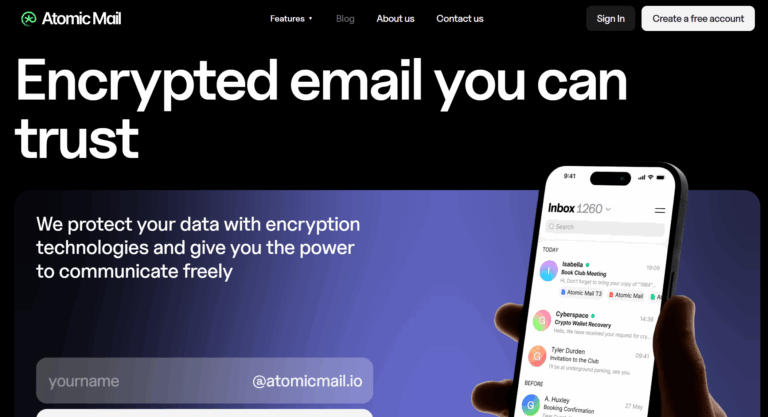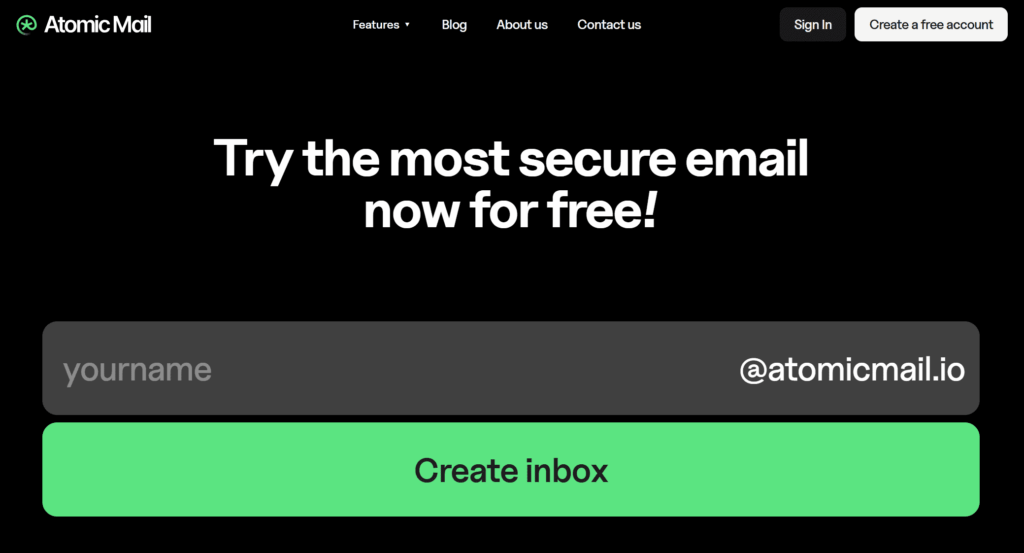What is Atomic Mail?
Atomic Mail is a free to use, secure email service solving privacy concerns with end-to-end encryption and alias creation for safe email communication.
Atomic Mail addresses privacy issues and provides end-to-end encryption and ensures only senders and recipients access messages. The zero-access architecture prevents even the provider from viewing emails. Users can create multiple aliases to protect their identity, ideal for managing spam or sensitive communications. Use it for secure sign-ups, private document sharing, or business communication.
Key Features of Atomic Mail
- End-to-End Encryption: Ensures only sender and recipient read emails, using ECIES for secure, private communication, protecting sensitive data.
- Zero-Access Architecture: Provider cannot access email content, enhancing privacy with a system designed to keep user data confidential.
- Email Aliases: Create unlimited aliases to mask real email, manage spam, and maintain privacy across different platforms or contacts.
- Password-Protected Emails: Add passwords to emails for secure sharing, even with non-Atomic Mail users, ensuring confidential data protection.
- Seed Phrase Recovery: Recover account access using a unique seed phrase, offering secure, user-controlled account restoration without compromising privacy.
- Two-Factor Authentication (2FA): Adds extra security layer, requiring secondary verification to prevent unauthorized access to user accounts.
- Spam-Free Inbox: Built-in filters eliminate junk emails, keeping inbox clean and focused on relevant, secure communication.
- TLS 1.3 Support: Uses advanced TLS 1.3 protocol for secure email transmission, protecting data during transit across networks.
How to Use Atomic Mail
- Sign up on atomicmail.io with no personal information or phone number required.
- Generate a unique seed phrase during account creation and store it securely.
- Log in to access the web-based email client or download the mobile app.
- Create email aliases from the dashboard to mask your primary email address.
- Compose emails, enable end-to-end encryption, or add password protection as needed.
- Enable 2FA in settings for additional account security.
- Use the spam filter to manage incoming emails and maintain a clean inbox.
- Recover account using the seed phrase if access is lost.
Key Use Cases for Atomic Mail
- Privacy-Conscious Communication: Individuals use it to avoid surveillance, ensuring emails remain private with encryption and aliases. Ideal for personal, secure messaging.
- Crypto Trading Security: Traders secure account sign-ups and communications, protecting sensitive financial data with encrypted emails and alias management.
- Business Confidentiality: Professionals share sensitive documents securely, using password-protected emails and encryption to maintain client or corporate data privacy.
- Spam Management: Users create aliases for online registrations, filtering spam to keep the primary inbox clean and organized for important communications.
Pros and Cons
Pros
- Free to use.
- End-to-end encryption ensures secure, private email communication for users.
- Email aliases help manage spam and protect user identity effectively.
- Zero-access architecture prevents provider access to email content, enhancing privacy.
- Seed phrase recovery offers secure, user-controlled account access restoration.
Cons
- Some learning curve for users switching from popular platforms like Gmail.
FAQs
Is Atomic Mail Free to Use?
Yes, it offers a free plan with 10 aliases, encryption, and spam filters; premium / business plans are under development.
How does Atomic Mail ensure privacy?
It uses end-to-end encryption, zero-access architecture, and TLS 1.3 to protect emails from unauthorized access.
What are email aliases in Atomic Mail?
Aliases mask your real email, allowing privacy for sign-ups and spam management with unlimited creation.
Does Atomic Mail support 2FA?
Yes, two-factor authentication adds an extra security layer to prevent unauthorized account access.






































